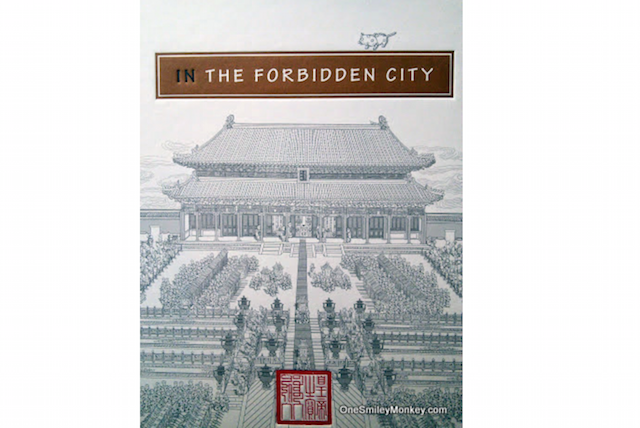By Pamela Chan, Contributor
“What are you doing?”, my husband asked me. While he was watching a movie, I was twisting a large white book around; checking photos on my laptop while comparing them to illustrations in the book; using a magnifying glass to look at details; and, muttering words like “aah” or “oh that’s the same statue” to myself.
Since I received a copy of In the Forbidden City by Chiu Kwong-Chiu, I’ve been getting my head around the scope of the book, the information that is presented inside and how it can be read. Presenting the history and stories about the Forbidden City’s almost 600 years of history would seem to be a daunting task.
What You Receive
The book includes 48 pages of detailed illustrations and text woven into a story that is designed to appeal to the mid elementary until middle school age group. Young children would be interested to use the magnifying glass to look at details in the illustrations – even if they can’t understand the more detailed aspects of the history of the Forbidden City.
The illustrations are detailed and plentiful and the stories are intriguing enough that anyone, of any age, would find the book illuminating. The book is published by Tuttle Publishing – a long time favourite publishing house of mine. If a book is published by this company I never let it leave my collection and can expect that it will be a special book. (Huge bias based on many years of loving their work!) Not surprisingly, the quality of the book’s binding and paper is very high.
A good number of the pages in the book fold out so that there is a long, continuous view of a portion of the Forbidden City stretched out across three pages. If you have a younger child or student looking at the book, it would be a good idea to show how to place the end of the foldout pages tucked back into the book without folding over the edges.
A piece of rectangular plastic that serves as a magnifying glass is included in the back of the book. While it is possible to make out the small details of the illustrations with the naked eye (if you have strong or well corrected vision), it is a good idea to use this magnifying glass to analyze small details more closely.
When you start to read the book and look more closely at the illustrations, the first thing you will notice is that there are what looks to be tourists walking and appearing throughout the illustrations. At first I couldn’t understand why there were pictures of past leaders and occupants mixed in with contemporaries walking around the palace. Then I realized that the author and illustrator is making a connection with the many tourists now who visit the Forbidden City for a few hours and the people who lived there long ago. Both people have inhabited the space for different periods of time. In the present, we can more closely identify withe the tourists. Maybe we have already toured the site or maybe this is something that we want to do.
Photo of a statue found in front of the Gate of Supreme Harmony near the entrance of the Forbidden City, along with an image of a photograph that a friend took and shared with me. When I think of the Forbidden City, I recall the strong colour themes that can be seen in the architecture and decorative elements.
I had an opportunity to visit the Forbidden City when I was a student. These were the days before China’s economy took off and many more tourists arrived in China. At that time, it took some planning to put together a trip to China. While there were a good number of people at the site the day that I went, I suspect that by today’s standards it would now be considered to have been almost empty by comparison. As you visit the city you realize that the site isn’t teaming with the privileged occupants and their staff members – as it once was – and most of the artistic treasures have been removed. However there are still many beautiful artifacts and interesting architecture and statues to see.
My favourite quadrant of the Forbidden City was the back right section of this large property. I found it to be quiet and very beautiful. For this reason, it was interesting to read this book and the find out how this area of the Forbidden City was built and used. It would be useful to analyze the illustrations and map in this book carefully before visiting the city.
My Thoughts
In The Forbidden City would be an interesting read for someone who has visited Beijing or who wants to go. Readers who like history or learning about the leaders of China and cultural history would also find it to be useful. Families with roots in the region or people living in an area with a strong Pacific-Rim culture would find the book to be informative. It could also make an interesting coffee table book as the magnifying glass invites the reader to take a closer look at the book. The approach that the author and illustrator has taken to presenting the lived history of the city makes you think about other palaces and places and what could be said about them.
When I first opened the book I was surprised to see that other than one large red seal, the illustrations are devoid of colour. When I thought about it I realized that due to the small and detailed quality of the illustrations, it would have been hard to add in colour. An unfortunate result is that people who haven’t seen the site in person or in photographs might not realize how vibrant the colour scheme on the property is. Perhaps in a future publication they could add in a few illustrations with full colour.
The book starts with a horizontal timeline presentation of the leaders over the centuries, along with a statement that describes the most important point that we should know about each one. This is an effective way to captivate the reader’s attention. Following this presentation, key moments in the history of the palace are described along with sections that include descriptions of portions of the City and why they were developed that way.
Mixed in amongst the stories and the illustrations (including historical features and an ever present cat) you can see countless images of tourists. The modern day visitor is never far from your mind while you read this book and the tales of what happened in the Forbidden City so many years ago seem fresh and relevant.
Disclosure: I received a sample of a product to facilitate my review. No other compensation was provided and all views and opinions stated on this post are 100% my own.









20 Comments on “In The Forbidden City {Book Review}”
This looks like a beautiful book!
Amazing! Would love to have this book, thanks for the review.
I could see my boys really enjoying this book.
What a beautiful book! I would love to read this with my girls.
Wow the details are incredible! It sounds like a great book!
What a great book….I’d have a hard time putting it down!
This looks like a beautiful book
I would read this book. It looks beautiful!
What a great book to read and discover
I like that they included a magnifying glass for you to inspect the details. It sounds like a fun yet educational book at the same time.
I love history and I think this would be an interesting book. Its nice to learn about other cultures and through pictures it makes it easy and enjoyable. I like how you described the book and had lots of pictures as examples.
wow, this sounds like a fascinating piece of history put into print. The Forbidden City has fascinated me since I heard about it as a teenager, the whole story is incredible and the buildings simply amazing.
I’ve been fascinated with the Forbidden City ever since I visited it. This book looks amazing, what a great way to find out more about this ancient history
Pamela Chan does a wonderful review of this book on the Forbidden City and leads me, to not only reading the book, but also to visit this ancient city. Well done, Pamela
Wow this is the most beautiful history book I’ve ever seen!
My grandson would love this book
This looks like a beautiful book!
I like that they actually included a magnifying glass for you to inspect the details.amazing
Would love to have this book for my brother,he loves books like this
So much history behind the Forbidden City, the name itself is intriguing. It must be a beautiful place to visit, despite most of the treasures having been removed.